“In accordance with a previous notice, a meeting was held at the Court House in the Village of Friendship, July 21, 1867, Rev.’s Perking and Bridgman presiding. A church was organized, named the Congregational Church of Friendship, and… Articles of Faith and a Covenant were adopted.”
Thus reads the opening paragraph of the Friendship Congregational Bible Church’s record books.
Friendship Congregational Bible Church The Reverend J. W. Perking served as the first pastor, and the seven charter members were: W. H. Quaw, Mrs. Sarah A. Harrison, Miss Leora B. Harrison, Mrs. Mary Ann Spencer, Luther B. Stowell, Dency Stowell and Austin Foster. Mrs. Sarah Harrison served as the first church clerk. The Lord’s Supper was administered on this day of organization, and the first child baptized within the new fellowship on that day was Charles Robert Harrison.
Two years later, in July 1869, the Reverend J. McChesney assumed the leadership of the church. Just prior to that, on May 8, the members made the decision to erect a building, and chose Messrs. Spencer, Stowell, Harrison and Quaw to solicit funds for this purpose. In addition to the soliciting, frequent offerings began being received during 1871, and the building fund gradually grew.
Action was taken in 1872 to incorporate the church legally, and a certificate of incorporation was filed with the Register of Deeds on August 12, 1872. In February of the next year, the Reverend P. R. Staples was called to be the new minister.
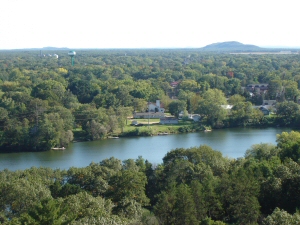
Friendship Congregational Church from the top of Friendship Mound
A deed dated August 22, 1872, was given to Aaron S. Spencer, Jerome B. Harrison and William M. Quaw, trustees of the church, from Lydia E. Quaw and David L. Quaw, conveying Lots No. 3 and 4, Block No. 1 of Newton and Hanfords Addition to the Village of Friendship to the church. It was upon the property that a building was later started, and it is upon this property that the present church stands.
The original building was made of wood, 28 X 48 feet, said to be able to accommodate 175 persons. By the time the building was completed in June of 1875, $802.47 had been raised in the building fund, and a loan was contracted with the American Congregational Union — probably what was later known as the Congregational Church Building Society — to cover the remainder of the total cost of $1,243.47.
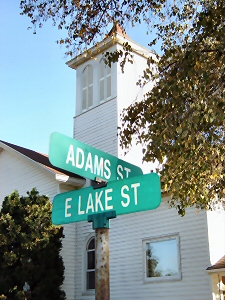
Located on the corner of Adams and Lake
On July 10,1875, the first church service was held in the new church building. On Saturday evening, November 13, 1875, a sermon preparatory to dedication of the new church was delivered by the Reverend J. W. Donaldson of Hancock, and for the dedication, visitors were present from the Quincy, Easton and New Chester churches.
Early the following year the pastor presented to the church a fine new Bible, a gift from Mrs. S. B. Chute of Sharon, MA. Also presented were singing books and papers for the Sabbath School. The exact date of the formation of this Sunday School is not known, but it certainly was before 1876.
It was reported in the Adams County Press dated April 19, 1879 that Susan B. Anthony, advocate for women’s suffrage lectured at the church on the stormy evening of April 10, 1879.
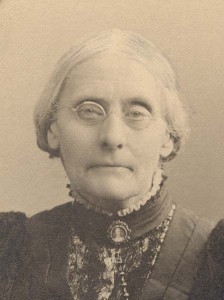
Susan B. Anthony
The exact date of the formation of the Ladies’ Aid Society is unknown. This is explained by the loss of an early record book of this society in 1895. The Society was then meeting upstairs in “The Williams Hall” the building located on the 300 block in Friendship (next to the Friendship Cafe). The building was not thoroughly completed; the record book was placed on a ledge at the top of the room, with space back of it, between the studs. The book was accidentally pushed back, fell down between the studs and could not be recovered.
The Reverend P. R. Staples seems to have remained the pastor until 1894 when he was forced to give up the work due to ill health. Rev. Marsden, a Methodist minister having a charge at White Creek, became pastor until 1896, when the Rev. J. A. Thomas was called as pastor.
In 1901, the Reverend C. H. Chase was called to the pastorate, and it was during his stay that a church parsonage was proposed and built. Mr. Chase was living in a house on 100 block of Main Street in Friendship. The house caught fire sometime in March 1901 or 1902, and Mr. Chase moved and lived for a time in what was then the G.A.R. Hall and the community became stirred to get a better house for the minister. A movement was started and a parsonage completed. The building still stands across the street from the church.
The Reverend A. H. Smith came to the pastorate late in 1902, and continued until 1907. He was followed by the Reverend J. M. Lavender, and in March of 1909 the Reverend J. T. O’Neill was called. Poor health caused his resignation a year later, and the Reverend James Deans followed.
Soon thereafter the village of Adams began growing rapidly. Mr. Deans organized a new Congregational Church there, and served both communities until April of 1913. The Reverend E. E. Day then served until 1915, and he was followed by the Reverend Mr. Vaughn.
On November 1, 1919, the Reverend Thomas Barker began a pastorate that was to last 11 years, yoked with Adams. The church grew considerably during this period, in a number of ways. The Sunday School prospered. A Missionary Society was formed, and gifts for benevolence increased. An organization for young people developed. There was considerable development in the community, and talk began in 1923 of enlarging and rebuilding the church. Up to that time it had remained in the same condition as it was when completed in 1875, except that it had been kept well painted, and the roof had been repaired a number of times.
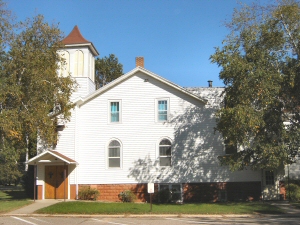 The enlarging and rebuilding project was started, and many of the residents contributed $100 and more toward rebuilding. Plans were worked out for raising the old building, putting a basement and dining hall, kitchen and furnace rooms in same. This plan gave the church a lecture room off the main auditorium, and individual donations, funds were given by a very active Ladies Aid organization — both at the time of construction and in later years as debts incurred in construction were repaid. A dedication service for the new additions was held on June 8, 1924.
The enlarging and rebuilding project was started, and many of the residents contributed $100 and more toward rebuilding. Plans were worked out for raising the old building, putting a basement and dining hall, kitchen and furnace rooms in same. This plan gave the church a lecture room off the main auditorium, and individual donations, funds were given by a very active Ladies Aid organization — both at the time of construction and in later years as debts incurred in construction were repaid. A dedication service for the new additions was held on June 8, 1924.
During the year 1930, Mr. Barker concluded his pastorate. The Reverend Harry F. Banks served until 1933. He was followed by the Reverend Walter R. Taylor, pastor of the Methodist Church at Coloma, who served until 1936.
It was in 1932 that the Ladies Aid inaugurated the Mother-Daughter Banquet, which came to be a popular annual event until 1969 when money making activities were discontinued.
By this time, the Reverend J. T. O’Neill, who had previously been pastor during 1909, was serving the Adams Congregational Church. At the annual meeting on January 10, 1938, Mr. O’Neill was given a call to serve the Friendship Church until such time as his pastorate at Adams should terminate. This proved to be a fruitful period of nearly 14 years. During this period the membership first passed the 100 mark. The Sunday School continued to grow, developing a Cradle Roll Department and a Home Department. The Ladies Aid continued to be very active, setting aside funds as early as 1942 that eventually resulted in another addition to the church building.
A new furnace was needed, but there wasn’t space for it. Additional Sunday School classrooms were needed. Construction began in 1950 on a 16 X 24 foot addition; a new oil burner was installed; new classrooms were made; the church sanctuary was beautifully redecorated. By the time of the dedication service for the new addition on October 14, 1951, an $8,000 project had been completed–the biggest share of it underwritten by the donations and hard work of the Ladies Aid.
Mr. O’Neill’s resignation took effect within three weeks after the dedication service. Reverend Samuel Robbins came to the pastorate in November, 1951 serving until October 1960. During his pastorate, an electric organ was purchased by the church in 1954 as a memorial gift. The purchase of the organ was made possible by the “Book of Golden Memories” started in 1947 and which gradually grew as a memorial fund. During Reverend Robbins pastorate, members and friends were kept abreast of church activities through a monthly newspaper, the “Parish Panorama”.
Space for the Sunday School was still not adequate, and the need for an additional stairway was great so church members again started talking of another addition. Talk soon led to the making of plans and to still more activity by the Ladies Aid to raise funds. Work was started on a 22 X 24 addition early in 1956 and was completed early in 1957. This $10,000 addition enlarged the dining room to seat 250, added a needed stairway, and provided large new rooms on the first and second floors. A dedication service was held on August 25, 1957 in conjunction with the observance of the 90th anniversary of the founding of the church.
When Samuel Robbins left in August of 1960, Reverend Wendell Bennetts of Plainfield occupied the pulpit until Reverend Charles Bryan was called in October of 1960. Reverend Bryan served until April 1964 when Reverend Bennetts again served as minister until Reverend Donald G. Graves was called in August 1964.
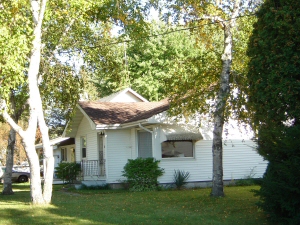
Church parsonage on Lake Street
A new parsonage was started in December 1963 and was ready for Reverend Graves and his family when they came in August of 1964. It was at the annual meeting that October that the congregation voted against joining the United Church of Christ causing a division with the church in Adams. However it wasn’t until September 1966 what the Adams Church canceled the contract of Rev. Graves and at the annual meeting on October 6, 1966, the congregation voted to hire Rev. Graves full-time at an annual salary of $5000 thus severing ties with the Adams Church. It was during this period the congregation was introduced to the scriptural teaching of salvation through faith in the shed blood of Jesus Christ.
 During 1965 the church was given a new look inside and out. Sidewalks, grass and shrubs were installed and new lights and pews were installed giving the auditorium one aisle instead of the two original aisles. The old pews were sold to the White Creek Church for $150. Also during this period a church library was begun.
During 1965 the church was given a new look inside and out. Sidewalks, grass and shrubs were installed and new lights and pews were installed giving the auditorium one aisle instead of the two original aisles. The old pews were sold to the White Creek Church for $150. Also during this period a church library was begun.
In October 1967 an attempt was made, but defeated, to change the church name to Friendship Community Bible Church. On January 28, 1979, the church name was officially changed to the Friendship Congregational Bible Church.
A school bus was purchased in the fall of 1967 for the purpose of picking up children for Sunday School. In use for about three years, the bus was painted bright blue and boasted the slogan “the largest Sunday School in Friendship”.
Donald Graves left the pastorate in December 1967 and the congregation called Rev. Ambrose Bandow of Atlanta, Georgia. In June of 1970 a Christian Education Director, Barbara J. Kappel, a Moody Bible Institute graduate, was hired to work with Sunday School teachers and young people. The Sunday School and youth work flourished. During this time the church basement was leased by the school district for use as a classroom due to the shortage of space in the public schools.
Upon the the retirement of Ambrose Bandow in the fall of 1974, Kenneth Mullen of Grand Rapids, Michigan, was called to serve from November 1974 until July 1982. A Children’s Choir was formed and the church newsletter “The Faithlifter” was published. The lot south of the church was purchased to be used in the future as a parking lot.
July 1982, Thomas Scholl of Grand Rapids, Michigan, was called to Friendship. Under his administration an active youth program was begun called “Coached By Christ” involving children from the community as well as church youth. Pastor Scholl served until January 1986. In the interim, Donald Graves once again served the church on a part time basis until January 1989. During this period, the church was completely resided.
Pastor David Havard of Niceville, Florida was called to serve from September 1989 through August 1995. Under the leadership of Pastor Havard, the church By-Laws and Constitution were completely revised.
Pastor Steven Hamilton of Bemidje, Minnesota served from May 1996 through July 2004. His ministry was known for warm home Bible studies and a down-home communication of Biblical truth.
In March 2002, Richard Church, son of members Charles and Karen Church, returned home from Florida to serve as Assistant Pastor. Having been raised in the Friendship Congregational Bible Church, he studied Aviation Computer Science at Embry-Riddle Aeronautical University. While in college, he was active in the Daytona Beach Baptist Church and later at Berean Bible Church of Edgewater, Florida.
In January 2005, the assembly selected Richard Church to officially serve as the pastor and he faithfully did so until December 2011. He continues to carry on a far-reaching Bible teaching ministry through the radio, camp and conferences, as well as cross-cultural missions beyond our borders besides serving as a faithful member and man in leadership of our church.
In May 2012, the Lord brought Timothy Board of the greater Chicagoland area to serve as pastor until March 2019. It was at that time that was called to minister with Things to Come Mission as the Development Director. His ministry was characterized by a passion for the sovereign majesty of Almighty God and the stewardship responsibility of the Church to live on mission “in Christ” for He is the One who is worthy of all praise both now and throughout eternity.
We are indebted, and deeply grateful, to the faithful men and women who had the vision to plant and launch the ministry of Friendship Congregational Church about 150 years ago. Over the years, many others have been used of the Lord to sustain the work and ensure that it not only survives but thrives. It is our prayer that the testimony of our lives would beckon the lost to come to Christ and challenge believers to surrender their lives to Christ in His service. This is our legacy that we endeavor to faithfully pass on to this and future generations to the praise of God’s glory both now and forever!
“Now to Him who is able to do exceedingly abundantly above all that we ask or think, according to the power that works in us, to Him be glory in the church by Christ Jesus to all generations, forever and ever. Amen” (Ephesians 3:20-21 NKJV).

